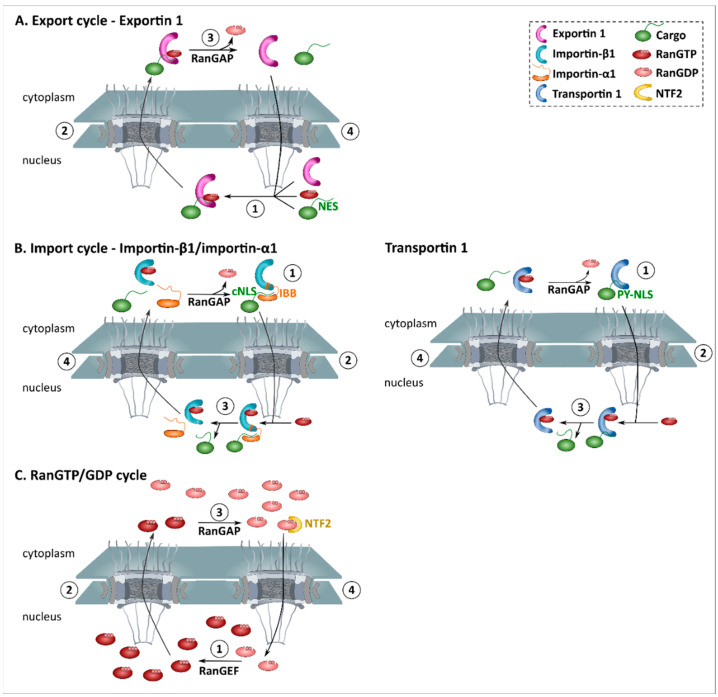Figure 2.
Schematic representation of Ran-dependent nucleocytoplasmic transport. Transport across the NPC is achieved by nuclear transport receptors, importins and exportins, and powered by a RanGTP gradient. (A) Nuclear export. (1) In the presence of high RanGTP concentrations, exportin 1 is able to bind cargoes containing a nuclear export signal (NES). (2). As exportin 1 has the unique ability to interact with the FG-repeats of the central channel, the exportin-cargo complex undergoes rapid passage through the pore. (3) In the cytoplasm, hydrolysis of RanGTP to RanGDP will cause the release of the cargo. (4) Exportin 1 is recycled back to the nucleus. (B) Nuclear import. (1) Due to the low affinity for RanGDP, importins bind their cargo in the cytoplasm. Left panel: a protein containing a classical nuclear localization signal (cNLS) is bound by the adaptor importin-α, which subsequently binds importin-β1 via its importin-β-binding domain (IBB). Right panel: proteins containing proline-tyrosine-nuclear localization signal (PY-NLS) are recognized by transportin 1. (2) Importins can transiently open the FG-meshwork of the central channel, allowing the passage of bound cargo. (3) In the nucleus, binding of RanGTP induces conformational changes, which induces cargo release. (4) Importins are exported back to the cytoplasm. (C) RanGTP/GDP cycle. (1) The high concentrations of RanGTP (Ran guanosine triphosphate) in the nucleus is maintained by RanGEF (Ran—guanine exchange factor). (2) RanGTP undergoes a continuous efflux out the nucleus via its binding to NTRs (see A and B). (3) RanGAP (Ran—GTPase activating protein) mediated hydrolysis of RanGTP into RanGDP, resulting in high concentrations of RanGDP (Ran guanosine diphosphate) in the cytoplasm. (4) RanGDP is imported into to the nucleus by NTF2 (nuclear transport factor 2) to restore depleted nuclear levels of RanGTP. Image is based on the review of Cook et al. [65].

